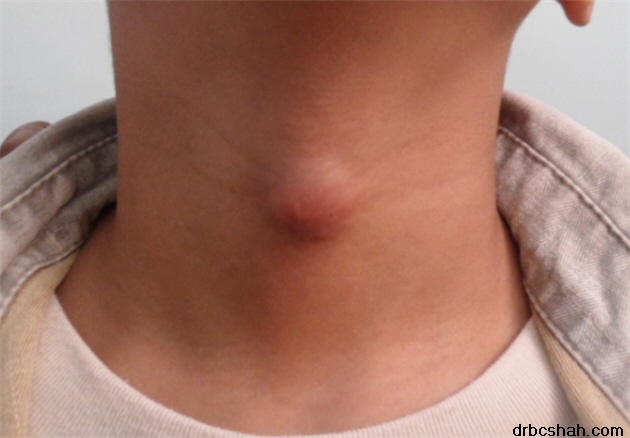Thyroglossal Duct & Cyst Removal
What is a thyroglossal duct cyst?
A thyroglossal duct cyst is a neck mass or lump that develops from cells and tissues remaining after the formation of the thyroid gland during embryonic development. It is most commonly diagnosed in preschool-aged children or during mid-adolescence, and often appears after an upper respiratory infection when it enlarges and becomes painful.
What causes a thyroglossal duct cyst?
A thyroglossal duct cyst is a congenital (present from birth) defect. When the thyroid gland forms during embryonic development, it begins at the base of the tongue and moves down the neck through a canal called the thyroglossal duct. This duct normally disappears once the thyroid reaches its final position in the neck. Sometimes, portions of the duct remain leaving cavities or pockets called cysts. These cysts can fill with fluid or mucus, and may enlarge if they become infected. Very enlarged cysts can cause difficulty swallowing or obstruct breathing passages.
What are the symptoms of a thyroglossal duct cyst?
The following are the most common symptoms of a thyroglossal duct cyst. However, each child may experience symptoms differently. Symptoms may include:
- A small, soft, round mass in the center front of the neck
- Tenderness, redness, and swelling of the mass, if infected
- A small opening in the skin near the mass, with drainage of mucus from the cyst
- Difficulty swallowing or breathing
The symptoms of a thyroglossal duct cyst may resemble other neck masses or medical problems. Always consult your child’s physician for a diagnosis.
How is a thyroglossal duct cyst diagnosed?
Generally, diagnosis is made by physical examination. The mass typically moves upward when the tongue is extended and with swallowing since the thyroglossal duct often connects at the base of the tongue. It is important to determine if the thyroglossal duct cyst contains thyroid tissues. In addition to a complete medical history and physical examination, diagnostic procedures for a thyroglossal duct cyst may include the following:
- Blood tests (to assess thyroid function)
- Ultrasound examination – to evaluate the muscle around the mass; a diagnostic imaging technique which uses high-frequency sound waves and a computer to create images of blood vessels, tissues, and organs. Ultrasounds are used to view internal organs as they function, and to assess blood flow through various vessels.
- Thyroid scans – a procedure that uses radioactive iodine or technetium (a radioactive metallic element) to reveal any physical abnormalities of the thyroid.
Treatment of a thyroglossal duct cyst:
Specific treatment of a thyroglossal duct cyst will be determined by your child’s physician based on:
- Your child’s age, overall health, and medical history
- Extent of the condition
- Your child’s tolerance for specific medications, procedures, or therapies
- Expectations for the course of the condition
- Your opinion or preference
Treatment may include:
- Antibiotic medication (to treat the infection)
- Surgical removal of the cyst and the thyroglossal duct, called the Sistrunk procedure
A thyroglossal duct cyst has a small chance of regrowing if small portions of the tissues remain after surgery. Infection of the cyst prior to surgery can make the removal more difficult and increase the chance for regrowth. Always consult your child’s physician for more information.


 Dr. Bimal Shah is the senior most General & Laparoscopic surgeon in Mira – Bhayandar with largest series of operations. He also consults at Borivali – Dahisar. He believes in ethical practice & is available at only trust hospitals. He passed out from KEM hospital, Mumbai in 1993 and was a lecturer training newer surgeons & medical students till 1998.
Dr. Bimal Shah is the senior most General & Laparoscopic surgeon in Mira – Bhayandar with largest series of operations. He also consults at Borivali – Dahisar. He believes in ethical practice & is available at only trust hospitals. He passed out from KEM hospital, Mumbai in 1993 and was a lecturer training newer surgeons & medical students till 1998. 






